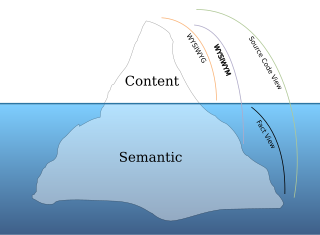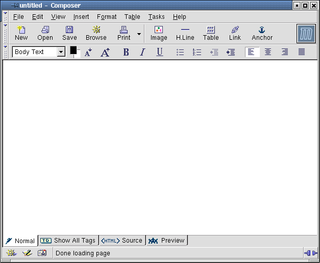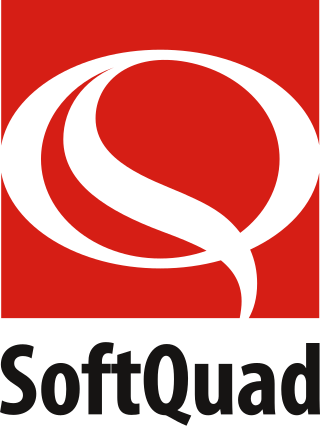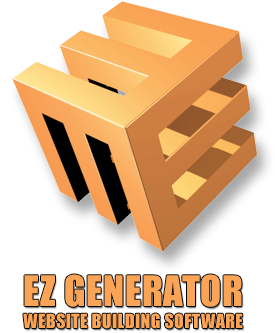
PaintShop Pro (PSP) is a raster and vector graphics editor for Microsoft Windows. It was originally published by Jasc Software. In October 2004, Corel purchased Jasc Software and the distribution rights to PaintShop Pro. PSP functionality can be extended by Photoshop-compatible plugins.
In computing, WYSIWYG, an acronym for what you see is what you get, refers to software that allows content to be edited in a form that resembles its appearance when printed or displayed as a finished product, such as a printed document, web page, or slide presentation. WYSIWYG implies a user interface that allows the user to view something very similar to the result while the document is being created. In general, WYSIWYG implies the ability to directly manipulate the layout of a document without having to type or remember names of layout commands.

WordPerfect (WP) is a word processing application, now owned by Alludo, with a long history on multiple personal computer platforms. At the height of its popularity in the 1980s and early 1990s, it was the market leader of word processors, displacing the prior market leader WordStar.
An HTML editor is a program used for editing HTML, the markup of a web page. Although the HTML markup in a web page can be controlled with any text editor, specialized HTML editors can offer convenience, added functionality, and organisation. For example, many HTML editors handle not only HTML, but also related technologies such as CSS, XML and JavaScript or ECMAScript. In some cases they also manage communication with remote web servers via FTP and WebDAV, and version control systems such as Subversion or Git. Many word processing, graphic design and page layout programs that are not dedicated to web design, such as Microsoft Word or Quark XPress, also have the ability to function as HTML editors.

In computing, What You See Is What You Mean is a paradigm for editing a structured document. It is an adjunct to the better-known WYSIWYG paradigm, which displays the result of a formatted document as it will appear on screen or in print—without showing the descriptive code underneath.

Mozilla Composer is the former free and open-source HTML editor and web authoring module of the Mozilla Application Suite. It was used to create and to edit web pages, e-mail, and text documents, and available for Windows, macOS and Linux. Composer was a graphical WYSIWYG HTML editor to view, write and edit HTML source code.
An XML editor is a markup language editor with added functionality to facilitate the editing of XML. This can be done using a plain text editor, with all the code visible, but XML editors have added facilities like tag completion and menus and buttons for tasks that are common in XML editing, based on data supplied with document type definition (DTD) or the XML tree.

UltraEdit is a text editor and hex editor for Microsoft Windows, Linux, and MacOS. It was initially developed in 1994 by Ian D. Mead, the founder of IDM Computer Solutions Inc., and was acquired by Idera Inc. in August 2021. UltraEdit is designed for users who focus on different types of software engineering. It is trialware.
In computing, formatted text, styled text, or rich text, as opposed to plain text, is digital text which has styling information beyond the minimum of semantic elements: colours, styles, sizes, and special features in HTML.
The following tables compare general and technical information for many wiki software packages.
Yuri Ivan Rubinsky was a Lebanese-born writer, software executive, and promoter of the Standard Generalized Markup Language (SGML), which was the basis for the now-ubiquitous XML. In Canada, he is probably best known as founding co-director of the Banff Publishing Workshop and for his work in applying technology to help visually impaired people. The Yuri Rubinsky Memorial Award was created posthumously in his memory.

Quick View is a file viewer in Windows 95, Windows 98 and Windows NT 4.0 operating systems. The viewer can be used to view practically any file.

The Oxygen XML Editor is a multi-platform XML editor, XSLT/XQuery debugger and profiler with Unicode support. It is a Java application so it can run in Windows, Mac OS X, and Linux. It also has a version that can run as an Eclipse plugin.

SoftQuad Software, Ltd., was a Canadian software company best known for HoTMetaL, the first commercial HTML editor. It is also known for Author/Editor, the first specialized SGML editor, and Panorama, the first browser plugin for SGML. Panorama demonstrated the need for standardization of SGML on the web, which eventually resulted in the development of the XML specification.

XMetaL, or XMetaL Author, is a software application people use to create and edit documents in XML and SGML. It has some features common to word processors, but is a native XML editor that can be configured to work with various standard and custom DTDs and XML Schemas. XMetaL was first released by SoftQuad Software in 1999 and is currently developed by JustSystems.

LibreOffice Writer is the free and open-source word processor and desktop publishing component of the LibreOffice software package and is a fork of OpenOffice.org Writer. Writer is a word processor similar to Microsoft Word and Corel's WordPerfect with many similar features, and file format compatibility.

EZGenerator is a web design program created by Image-Line. The program is intended to be accessible to users with no experience in code such as HTML or CSS, and displays results in a WYSIWYG manner. EZGenerator is available for Windows operating systems. As of February 21, 2017, EZGenerator is no longer being developed, nor is it available to download unless done by an existing customer through their personal licenses page.










